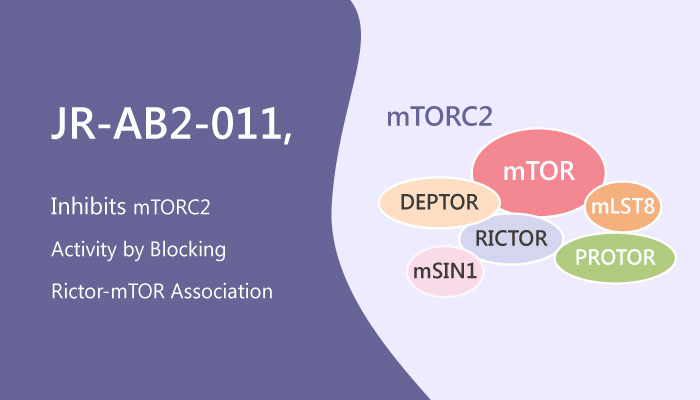Glioblastoma multiforme (GBM) are highly malignant and invasive tumors. It not only can prevent total surgical resection, but also render these neoplasms refractory to cheJR-AB2-011 is a selective mTORC2 inhibitor with an IC50 value of 0.36 μM. JR-AB2-011 inhibits mTORC2 activity by blocking Rictor-mTOR association (Ki: 0.19 μM). JR-AB2-011 has anti-glioblastoma multiforme (GBM) propertiesmotherapeutic interventions. Thus, exploiting novel therapeutic options is necessary while circumventing resistance mechanisms. The mechanistic target of rapamycin (mTOR) kinase is the major mediator of phosphatidylinositol 3-kinase (PI-3K) signaling. Meanwhile, It is also an important target for molecular therapeutics in GBM.
mTOR-mLST8-Raptor complex (mTORC1) and mTOR-mLST8-mSIN1-Rictor complex (mTORC2) have a common element mTOR. But, They perform several different functions. Recent data indicate that mTORC2 activity is essential for characteristics of these tumors, including transformation and invasion. JR-AB2-011 is an inhibitor of mTORC2 with an IC50 value of 0.36 μM, which specifically blocks the interaction of the regulatory subunit Rictor with mTOR. However, mTORC1 signaling is unaffected.

In vitro, JR-AB2-011 at dosing regimens markedly enhances apoptosis according to cellular assays. Furthermore, JR-AB2-011 displays the least toxicity to normal neurons with no significant cytotoxic effects for concentrations up to 10 mM compared to JR-AB2-000 analogs.
On the other hand, Compared to mice receiving vehicle alone, JR-AB2-011 at either dosing regimen displays marked inhibition of tumor growth rate. It is consistent with the effects on xenograft growth, Mice at either JR-AB2-011 dosing regimen significantly promotes survival relative to vehicle treated mice. Notably, mice tolerate both of these dosing regimens without obvious short or long-term toxicity or weight loss.
In summary, mTORC2 is a viable therapeutic target in GBM. JR-AB2-011 inhibitor blocks mTORC2 signaling in these tumors, which shows significant anti-tumor properties.
Reference:
1. Benavides-Serrato A, et al. PLoS One. 2017 Apr 28;12(4):e0176599.